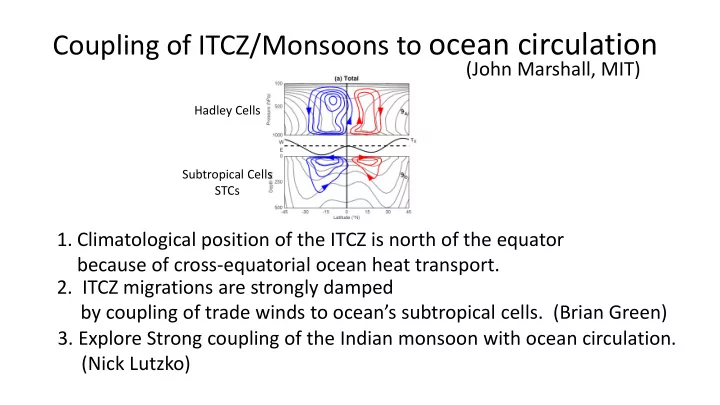

Coupling of ITCZ/Monsoons to ocean circulation (John Marshall, MIT) Hadley Cells Subtropical Cells STCs 1. Climatological position of the ITCZ is north of the equator because of cross-equatorial ocean heat transport. 2. ITCZ migrations are strongly damped by coupling of trade winds to ocean’s subtropical cells . (Brian Green) 3. Explore Strong coupling of the Indian monsoon with ocean circulation. (Nick Lutzko)
ITCZ resides in the warm hemisphere � � � Equator Obvious explanation for relative Kang et al, 2008 warmth of the Northern Hemisphere might be albedo differences. However…..
Symmetry of Hemispheric planetary albedos � p � 0.298 � p � 0.299 Note, a 0.01 difference in � p implies a Donohoe and Battisti, 2011, J. Climate cross-equatorial heat transport of 0.2PW. Voigt et al, 2013: J. Climate Stevens et al, 2015, GRL
NH is warmer than the SH because of ocean circulation All oceans Atlantic Trenberth and Caron, 2001 Atmospheric heat transport is southward at the equator Atlantic To compensate, ITCZ shifts north to ensure that atmosphere transports Sv heat south across Equator Lumpkin and Speer, 2007
ITCZ is in the NH because of ocean circulation Kang et al, 2008 � � � Donohoe et al, 2013; Frierson et al, 2013; Marshall et al, 2014; Schneider et al, 2014; Stevens et al, 2015 Heat transport can be up-gradient in the ocean because the ocean is mechanically forced
Coupling of ITCZ/Monsoons to ocean circulation (John Marshall, MIT) Hadley Cells Subtropical Cells STCs 1. Climatological position of the ITCZ is north of the equator because of cross-equatorial ocean heat transport. 2. ITCZ migrations are strongly damped by coupling of trade winds to ocean’s subtropical cells . (Brian Green) 3. Explore Strong coupling of the Indian monsoon with ocean circulation. (Nick Lutzko)
Overturning Circulation Surface Winds ITCZ on the Equator
Overturning Circulation Anomalous Surface Winds Northward ITCZ shift
Overturning Circulation Anomalous Anomalous Surface Ocean Ekman Winds Transport Northward ITCZ shift
Overturning Circulation Anomalous Anomalous Asymmetric component Surface Ocean Ekman of overturning circulation Winds Transport Northward ITCZ shift
Overturning Circulation Anomalous Anomalous Asymmetric component Surface Ocean Ekman of overturning circulation Winds Transport Anomalous heat transport Northward ITCZ shift
The ITCZ is ‘sticky’ MITgcm with Frierson moist physics slab w here ‘ c ’ is the compensation Coupled, Double Drake Green and Marshall, J. Climate, 2017 Forced minus control 2.5 0.4
Dynamics of the Ocean’s Cross -Equatorial Cell at depth
Dynamics of the Ocean’s Cross -Equatorial Cell at depth Literature on the Cross-equatorial Fritz Schott (observationally) Cell of the Indian Ocean Jay McCreary (theoretically) and collaborators
Coupling of Monsoon with Ocean Circulation Ekman transport Schematic from Peter Webster Asymmetric component of overturning Loschnigg and Webster, circulation in Indian Sector J. Climate, 2000 1. Coupling of Hadley Cell with ocean’s subtropical cells 2. Damping of ITCZ migrations (Brian Green) 3. Coupling of monsoons with ocean circulation (Nick Lutsko)
Minimalist model of coupling of Monsoon to the ocean GFDL dynamical core, 0.5 m deep swamp Frierson physics 40 Seasonal Cycle 15 Equator 24m mixed layer with interactive q-flux Surface stress from atmospheric model τ 𝑦 Ocean heat transport: Temperature difference 𝐺 ϕ = 2π𝑏cosϕ𝑑 𝑞 𝑔 Δ𝑈 across the thermocline. Prescribed and held constant
Surface winds, precipitation and Moist Static Energy Swamp Interactive ocean Summer Δ𝑈 = 10𝐿 MSE MSE
Swamp Interactive ocean Precipitation Land Sector Land Sector Δ𝑈 = 10𝐿 (time ) (time ) Ocean Sector Ocean Sector
Precipitation Observed Surface wind and precipitation Animation courtesy of Simona Bordoni
Enhancing role of ocean circulation Increasing Δ𝑈 Summer MSE SST OCEAN LAND OCEAN LAND Surface Precip wind OCEAN OCEAN LAND
Enhancing role of ocean circulation Increasing Δ𝑈 Summer MSE SST OCEAN LAND OCEAN LAND Surface Precip wind OCEAN OCEAN LAND
Enhancing role of ocean circulation Increasing Δ𝑈 Summer MSE SST OCEAN OCEAN LAND LAND Surface Precip wind OCEAN OCEAN LAND
Enhancing role of ocean circulation Increasing Δ𝑈 Summer MSE SST OCEAN LAND OCEAN LAND Surface Precip wind OCEAN OCEAN LAND
Overturning circulation
� Overturning circulation and zonal wind � ci=2m/s westerlies
Monsoon Indices Increasing Δ𝑈 Increasing Δ𝑈 � � � �
Ocean Heat Transport Summer OHT OHT at EQ (PW) (PW) LAND (time )
Summary W/m 2 Western boundary currents in the Net downward Atmosphere and Ocean surface heat flux Ekman Transport Peter Webster and collaborators
Conclusions Coupling of the trade winds with ocean’s subtropical cells in the deep tropics has a profound effect on rainfall patterns: Strongly damps ITCZ migrations Fundamental to the dynamics of the Indian Monsoon Many discussions with Brian Green, David McGee, Alan Plumb, Nick Lutsko, MIT Aaron Donohoe, Dargan Frierson, UW Simona Bordoni, Tapio Schneider, Caltech Peter Webster, Georgia Tech
In present climate there is a small 0.2 PW net (A+O) northward transport of heat across the equator If this transport was achieved by atmosphere, ITCZ would be south of equator! Donohoe et al, 2013, J. Climate Marshall et al, 2014; Climate Dynamics
In present climate there is a small 0.2 PW net (A+O) northward transport of heat across the equator AHT � OHT � 0 OHT � 0 and so, atmospheric heat transport must be southward AHT � 0 ITCZ is ‘pushed northward’ by OHT If this transport was achieved by atmosphere, ITCZ would be south of equator! Donohoe et al, 2013, J. Climate Marshall et al, 2014; Climate Dynamics
ITCZ is in the NH because of ocean circulation Kang et al, 2008 � � � Donohoe et al, 2013; Frierson et al, 2013; Marshall et al, 2014; Schneider et al, 2014; Stevens et al, 2015
Recommend
More recommend